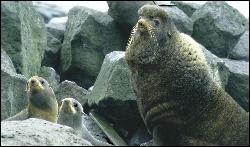
Beginning in May, the seals start returning to the breeding islands. Older males, or bulls, arrive first to vie for prime breeding territories prior to the arrival of females. Breeding males are typically 10 or more years old, maintain females within their territories, and accomplish the majority of breeding. Idle males are adult males within the size and age range of breeding males but do not maintain females and may or may not be territorial. Males holding territory remain on territory for an average of 50 days and fast during that time, losing 20%-25% of their mass (Johnson 1968). There is some turnover of breeding males later in the season when some idle males become breeding males. Sub-adult males, or SAMs, usually congregate on shore in areas called "haulouts" during the summer breeding season. There is a typical structure to fur seal rookeries, the core group of breeding males with females, idle males without females on the fringe of the core area, and idle males and sub-adult males on haulouts outside the rookery areas.
Females typically start returning to the breeding islands in June and give birth to a single pup within a few days after arrival on land. Females generally have their first pup at 5-6 years of age and copulate 5-14 days after giving birth. Females suckle their pups for 2-4 days and then go to sea for 4-14 day feeding trips. Pups are nursed until weaning and migration in November and may not return to the islands until their second year of life. The pregnancy rate for females is approximately 60% for females age 3 and greater, and 68% for females age 4 and greater (York 1987). Nearly 90% of females in their reproductive prime, 8-13 years old, are pregnant every year with the pregnancy rate gradually decreasing after 13 years of age. Survival rates for female and male fur seals vary by age (Lander 1981).

